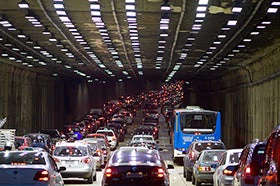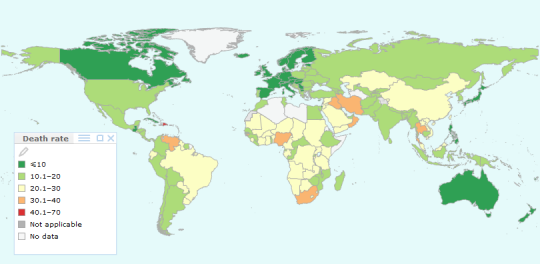 According to WHO data,
road transport kills about 1.3 million people each year, turning into the
8th leading cause of death worldwide. Although road deaths are a global epidemic, Latin America has been hit particularly hard by the road safety crisis: the region accounts for a tenth of traffic fatalities and 6 million serious injuries every year, although it is home to only 6.9% of the world’s population.
According to WHO data,
road transport kills about 1.3 million people each year, turning into the
8th leading cause of death worldwide. Although road deaths are a global epidemic, Latin America has been hit particularly hard by the road safety crisis: the region accounts for a tenth of traffic fatalities and 6 million serious injuries every year, although it is home to only 6.9% of the world’s population.
Within that regional context, Brazil, often on the frontline and seen as an example by many on the development agenda, lags behind in road safety, especially when compared to nations with similar socioeconomic characteristics. Recently, the federal and state governments have started to take concrete action in an effort to stop the carnage on their roads, and a recent seminar on road safety in Sao Paulo gives some reasons to believe that Brazil is indeed moving in the right direction.
Estimated Road Traffic Death Rate (per 100,000), 2010


Source: WHO, Global Health Observatory, accessed May 22, 2014
Yet, the country has a long way to go: Brazil’s death toll rate ranges anywhere between 23 and a staggering 27 deaths per 100,000 inhabitants (depending on the source of data) – this is slightly higher than India and China, and substantially higher than the best-performing countries in the world, which are well below 5. A national road safety strategy was adopted in 2004-2005 and there have been many sporadic but valuable initiatives since then. However, the main issues faced by the country remain the lack of integrated and results-driven policy resulting from a general lack of both inter-sectorial and inter-jurisdictional coordination between Federal, State and municipal governments, as well as insufficient involvement of civil society.
The State of Sao Paulo is one of Brazil’s most advanced States, with a GDP of RS$1,247 billion (2010, about US$500 million), and one of Brazil’s highest GDP per capita (US$16,200 in 2010, more than 50% above the national average). Yet, mirroring the national situation, it suffers a significant road safety problem, with a death rate which may be as high as 27.4 deaths per 100,000 inhabitants, depending on the source and methodology of assessment. This is exacerbated by rapidly increasing motorization, especially with recent rapid growth in motorcycle transport in cities.
So what can be done to prevent the situation from deteriorating even further and stem the tide of traffic-related deaths in the country?
In 2013, the World Bank committed $300 million to the Sao Paulo State Sustainable Transport Project, an innovative operation aimed at improving the efficiency and safety of transport and logistics as part of the broader State agenda on climate change. Two pilot studies on road safety were launched in 2013 during the Project preparation, with funding from the Global Road Safety Facility (GRSF): a Road Safety Management Capacity Review and an international Road Assessment Program (iRAP) on a sample of 4,250 km of roads on the Sao Paulo network. Those studies were seen as an opportunity to better assess the situation of road safety in the State and beyond, in the country, and more generally to advance the road safety agenda throughout Brazil.
Building on the conclusions from both studies, an international road safety seminar was organized in Sao Paulo on April 28-29, 2014, in an effort to raise awareness, leverage action and promote collaboration among different stakeholders in Brazil.
The seminar insisted on the importance of a multi-sectorial approach to road safety that involves not only transport but also law enforcement, health, education and others stakeholders such as insurance companies, non-governmental organizations and international institutions ( Pan American Health Organization, Ibero-American Road Safety Observatory).
Based on the recommendations of the Road Safety Capacity Review, the State of Sao Paulo made very concrete proposals for improving road safety at the State level – starting with proposals to structure a lead agency, which would be unprecedented in Brazil. Similarly, the presentation of the results of the iRAP study on almost 4,250 km of roads garnered a lot of attention from the audience. It also led to a commitment to include at least part of the recommendations in the coming road investments programs and expand the evaluation to other roads in the State.
As my colleague Boris Utria World Bank’s Brazil Deputy Director, pointed out in his opening remarks, Brazil could do to road safety what it did for conditional cash transfer programs with ‘Bolsa Familia”: it could lead the road safety agenda in the developing world and be an example for other countries in the reduction of traffic fatalities. There is no shortage of urgent work to be done: as earlier mentioned, road traffic injuries are the 8th leading cause of death globally, and the leading cause of death for people aged 15–29. Brazil should be congratulated for its commitment to move quickly on this agenda. I hope that this determination will now translate into concrete action, and that I will soon be able to report back on the implementation of some of the measures discussed during the seminar.


Join the Conversation